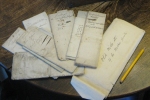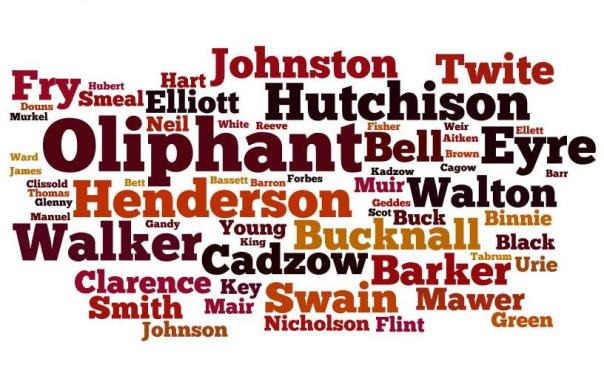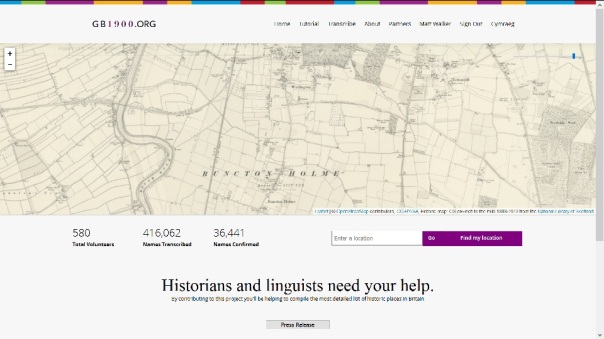 I was tempted last week by the offer of a weekend of free on-line access to “billions of historical records” at FindMyPast.co.uk. And after a great talk at my local Family History Society meeting, by Myko Clelland from FindMyPast, I decided to sign up, give it a go, and see what new things I could find. So I registered, and uploaded a GEDCOM file, with nearly 4,500 people in it. Then I had an initial explore of the site, and waited for the free access weekend to start.
I was tempted last week by the offer of a weekend of free on-line access to “billions of historical records” at FindMyPast.co.uk. And after a great talk at my local Family History Society meeting, by Myko Clelland from FindMyPast, I decided to sign up, give it a go, and see what new things I could find. So I registered, and uploaded a GEDCOM file, with nearly 4,500 people in it. Then I had an initial explore of the site, and waited for the free access weekend to start.
The FindMyPast website was not as good as I had hoped! I’ll explain how I got on as a new user, and in particular the things that frustrated me about the site.
The first thing I found disappointing with the site was that the “Hints” system which FindMyPast advertises as a great way to find new, relevant records to help build up your family tree, only works (currently) when you edit entries, or manually enter new ones. It doesn’t provide hints for the people that you’ve added from a GEDCOM file! FindMyPast should make it clearer before you start that when uploading a GEDCOM file you won’t get “hints” for the individuals in that file.
 My next frustration was that when I did start getting “Hints” (after adding details from paper notes that were missing from the GEDCOM file) – although at first sight many hinted records looked to be relevant, digging deeper revealed that they really weren’t relevant to my tree. A couple of times I added facts to my tree using the hints provided by FindMyPast, but then deleted them again after looking much more closely and checking back on my paper notes of details I’ve previously found! (this largely related to parish registers from the 1700’s).
My next frustration was that when I did start getting “Hints” (after adding details from paper notes that were missing from the GEDCOM file) – although at first sight many hinted records looked to be relevant, digging deeper revealed that they really weren’t relevant to my tree. A couple of times I added facts to my tree using the hints provided by FindMyPast, but then deleted them again after looking much more closely and checking back on my paper notes of details I’ve previously found! (this largely related to parish registers from the 1700’s).
It appears to me that FindMyPast‘s threshold for matching the information to provide its “Hints” may be set too low! Many of its hints can be very quickly screened out. But the difficulty comes with the ones that you have to dig into much more deeply to detect the inconsistencies. It is so easy to see something that seems to match, and add it to your tree. This could so easily lead to many false paths in numerous family trees.

AFamilyHistoryBlog is (in part) my attempt to counter some of these “false” trees that appear on-line, where people have assumed connections to exist between separate records, but without any clear evidence for the connection. I hope that by posting the real evidence that I have from original family documents and other reliable sources, I can help to challenge and correct some of those “false” trees which can so easily develop. I also hope that if and when I follow a false path, my blog will allow others to contact me with any evidence they have, to put me back on the right path.
I had hoped to find many more images of original documents to be available to view on the FindMyPast website. But while it does have images of things like census records (which is useful), it doesn’t seem to have images of the parish registers which I had hoped for! Only the transcriptions of them!
Very often seeing images of the original parish registers (which I have done in the past on microfilm) provides additional clues/evidence that is too often missing from the transcriptions; for instance names of witnesses (who often may have been relatives), or names of places (houses/farms) where the people lived, which can confirm a continuity between different records. Without establishing such continuity between records you often can’t be certain if the name appearing several times in a parish register relates to one person, or to several different people with the same name. It was very common in the past, when extended families often lived geographically close together, to find cousins or second cousins, or uncles/aunts & nephews/nieces, who shared the same names, living in the same parish. So in the records (and more-so in their partial transcriptions) it can be very difficult to tell these individuals apart!
After these initial frustrations with the FindMyPast system, where I was largely trying to find more about earlier ancestors through parish registers, etc – largely the Walkers of Kirkliston (whom I’m currently posting documents about), I decided to change track. I began to have a look at the lines of my ancestry that I can trace least far back. From my 3x Gt-grandparents back, some gaps begin to appear. So I began looking to see if FindMyPast could help fill any of these gaps.
That generation of my tree typically features individuals born in the late 1700’s and particularly the early 1800’s – people who often had their families at the time of the early censuses. So it proved easy to find out some more about some of these ancestors from the UK censuses. In one case I have been able to obtain the maiden name of a 3x Gt-grandmother, where before I only had her married surname.
 Elsewhere I was able to work out sideways, adding children and other details in the next generation. But this also produced one more frustration with the FindMyPast system. FindMyPast would try to use the census data about a household to identify everyone in the family and use that to update or add individuals in your family tree. But too often it risked duplicating individuals because slight differences in name spelling meant that it didn’t link the person in the census to the person in your tree! And you couldn’t easily compare the full household list in the census with the whole family group in your tree, to check who was there and who was missing.
Elsewhere I was able to work out sideways, adding children and other details in the next generation. But this also produced one more frustration with the FindMyPast system. FindMyPast would try to use the census data about a household to identify everyone in the family and use that to update or add individuals in your family tree. But too often it risked duplicating individuals because slight differences in name spelling meant that it didn’t link the person in the census to the person in your tree! And you couldn’t easily compare the full household list in the census with the whole family group in your tree, to check who was there and who was missing.
In one case I added a “son-in-law” from the census to my tree. I already had the son-in-law in my tree, but FindMyPast didn’t connect the two together, or connect the son-in-law from the census to his wife in my tree (who was also in that census entry), but only to his parents-in-law! So “Henry” then appeared twice in my tree – a duplicate! I tried to find out how I could merge the two entries into one! But I couldn’t!
The best help I could find was on a blog by Phil Moir, who is “technical lead for the Family Tree team” at FindMyPast. That helped a little, but wasn’t exactly what I wanted! In the end I had to resort to copying the new details provided by the census, from the “new” Henry, and pasting them into the profile of the “old” Henry, then delete the “new” Henry from my tree. Not very satisfactory! It should be much easier to merge two “profiles” into one.
 Another example of the problem with FindMyPast‘s handling of census records is where a child in a family had died. Then a new child was given the same name, which was common when child mortality was high – in this example “William”. The 1891 census records the younger William (b.1886). But the FindMyPast system picks up on the older “William” in the family tree (b.1867), who had died (1871) before the 1891 census, and attempts to persuade you to change his date of birth to that of the younger James, who is in the census and on your tree. If you were to follow through on FindMyPast‘s advice and update “William’s” details based on the census record, then you would have two “William”s with the same approximate date of birth in the family group. This would then look like a duplicate of one individual (similar to what I described above), when in fact they were two different individuals, with a wide gap between dates of birth.
Another example of the problem with FindMyPast‘s handling of census records is where a child in a family had died. Then a new child was given the same name, which was common when child mortality was high – in this example “William”. The 1891 census records the younger William (b.1886). But the FindMyPast system picks up on the older “William” in the family tree (b.1867), who had died (1871) before the 1891 census, and attempts to persuade you to change his date of birth to that of the younger James, who is in the census and on your tree. If you were to follow through on FindMyPast‘s advice and update “William’s” details based on the census record, then you would have two “William”s with the same approximate date of birth in the family group. This would then look like a duplicate of one individual (similar to what I described above), when in fact they were two different individuals, with a wide gap between dates of birth.
You really need to be able to compare the census records, and what FindMyPast is hinting you to change in your tree, side-by-side with the WHOLE family group that you currently have in your tree. You need to be better able to see the context of the wider family into which you’re being prompted to add new details of an individual. As far as I can see at the moment the best that you can do is to switch between the “merge” page and the “family view”, in separate browser tabs. This isn’t satisfactory. You should be able to view them side-by-side, in the same tab, in order to fully check how the details in the hinted record compare to the family group that you already have in your tree.
So, to summerise my experience; while FindMyPast could be very useful as a research tool, the frustrations that I’ve had as a new user trying it out for the first time, mean that I can only give it 2 stars! ★★☆☆☆
The free Family Tree Builder app is great and I’ll probably continue to play with it, adding material that I’ve got elsewhere. It looks great. I just wish it was a bit easier to navigate between different branches of my tree. A tab at the top of the “family view” that would let you get quickly to an index of all the individuals in your tree would be great for that.
The available records that you can search is also good. But I think that the systems of “Hinting” records, and of merging record details into your own family tree needs improvement (I realise that this is sure to be a very technically challenging thing to get right!).
So I think that I am unlikely to take out any kind of subscription to FindMyPast until I can see them ironing out many of the frustrations that I’ve mentioned above. Once they do, it’ll be a really great tool.
Following a link to one of Ben’s sources about the WIGHAM family, I’ve just started reading the “Memoirs of the Life, Gospel Labours, and Religious Experience of John Wigham”, published in 1842 (3 years after his death). There are two digitised copies of the book available on-line.
 In e-mail messages we’ve exchanged, Ben Beck has suggested that I may find the Quaker Family History Society of interest. This is certainly something that I’ll be looking at, as I also have well-known Quakers on the opposite side of my family; the FRYs. (See my ELLIOTT tree).
In e-mail messages we’ve exchanged, Ben Beck has suggested that I may find the Quaker Family History Society of interest. This is certainly something that I’ll be looking at, as I also have well-known Quakers on the opposite side of my family; the FRYs. (See my ELLIOTT tree).



 I will continue posting articles about my own family history research onto
I will continue posting articles about my own family history research onto 



 This is a good follow-up to the article that I wrote a few months ago for my local Family History Society (which I copied onto AFamilyHistoryBlog) about my
This is a good follow-up to the article that I wrote a few months ago for my local Family History Society (which I copied onto AFamilyHistoryBlog) about my 













 I will be asking all my close family to have a look at the site over the next few weeks, and to let me know what they think of it. One of my biggest challenges in making the site live was in amending all the site’s internal web-links; the links from one page or blog-post to another. I hope that as people explore the site, they will test these internal links and will let me know if they find any “broken” ones – either via the
I will be asking all my close family to have a look at the site over the next few weeks, and to let me know what they think of it. One of my biggest challenges in making the site live was in amending all the site’s internal web-links; the links from one page or blog-post to another. I hope that as people explore the site, they will test these internal links and will let me know if they find any “broken” ones – either via the